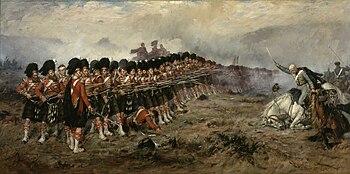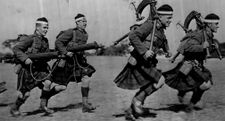Rí-Fórsaí Armtha
| His Majesty's Armed Forces | |
|---|---|
| Rí-Fórsaí Armtha | |
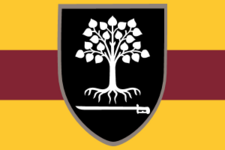 Emblem of Rí-Fórsaí Armtha | |
| Founded | 1542 |
| Service branches | Rí-Airm Rí-Dúghorm |
| Headquarters | Neuaddduwiau, tir Lhaeraidd |
| Leadership | |
| Commander-in-Chief | Bedwyr XVI, Teyrn |
| Aire Cosanta | Leonard ui'Neill |
| Ceann Foirne | Gareth O'Regan |
| Personnel | |
| Military age | 18 |
| Conscription | None |
| Reaching military age annually | (512,000) |
| Active personnel | 400,000 |
| Reserve personnel | 150,000 |
| Expenditure | |
| Budget | $162.3 billion |
| Percent of GDP | 3.12% |
| Industry | |
| Domestic suppliers | Brenner Ballistics Daimyo Grendel Shouyi Hawker Aeronautics Mag-Torc Met Fabrikan Resh Fabrikan |
| Annual exports | Midrasia |
Rí-Fórsaí Armtha (lit. "His Majesty's Armed Forces") (Acronym: R-FA) are the military services charged with defending tir Lhaeraidd and its interests. The R-FA consists of Rí-Airm (lit. "His Majesty's Army") and Rí-Dúghorm (lit. "His Majesty's Navy"), both of which maintain their own Air Detachments; Fórsa Aer Airm and Fórsa Aer Dúghorm respectively. R-FA have never commented on their nuclear capabilities if they have any, and there are no known nuclear weapons facilities in tir Lhaeraidd, however it is widely accepted that the R-FA does maintain the ability to produce nuclear weapons but does not maintain a standing nuclear force. In addition to their defensive role the R-FA are primarily responsible for overseeing the distribution and implementation of humanitarian aid programmes, as well as peacekeeping operations, and armed support operations for allied nations.
The modern R-FA is one of the best equipped, trained, and organised military forces in Asura and has been involved in successful operations in Cuirpthe and the Araabyne during the Folksland Crisis and Fourth Brush War respectively. R-FA forces were deployed along a line referred to as LD1 in Cuirpthe where they maintained a defensive line preventing further advances by Folksland forces into Cuirpthean territory; meanwhile elements from Fórsa Aer Airm and Fórsa Aer Dúghorm provided both close air support and med-evac services to Cuirpthean forces on the ground. R-FA forces entered the Araabyne at the request of the PRA in early 2018 and brought about an end to the war, they would subsequently remain on deployment in the country as a peacekeeping force where they remain today.
Its Commander-In-Chief is the Lhaeraidh monarch, currently Teyrn Bedwyr XVI, with the exception of the Swiftriver Regiment which recognises the Heir Apparent, currently Gwynyth merch Brienne, as their Commander-In-Chief. The Dáil approves the R-FA's budget every five years based upon recommendations from the Aire Cosanta (lit. "Secretary of Defence") who is currently Leonard ui'Neill, who was appointed by the Taoiseach, Líadáin Síomha upon her election in 2017. All members of the R-FA swear allegiance to the Commander-In-Chief and all new commissioned officers are required to take a further oath to the Commander-In-Chief and the Taoiseach.
The R-FA are involved through various treaty obligations with the armed forces and defence of the Araabyne, Crylante, Cuirpthe, the Mardin Isles, Navack, and Vrnallia.
History
The Lhaeraidh Armed Forces have played a major role in Asuran and global military history. Tir Lhaeraidd was one of the first Asuran military powers to adopt a modern professional army, and later gunpowder weapons. From the 16th until the 19th century they were involved in armed occupations in modern day Crylante and Vrnallia. The Lhaeraidh Army Model, formulated in the 16th century helped to revolutionise the way in which land wars were fought, and how armies were trained and maintained. The Navy meanwhile would prove key from the 17th Century onward for maintaining the trade lanes and outposts upon which the Lhaeraidh global trade network relied.
Origins
Prior to the formation of the R-FA the military of tir Lhaeraidd was highly inconsistent and largely unorganised. By and large military units were led by members of the gentry or nobility and were equipped and trained according to the wishes of their commander; any noble who raised a military force was entitled to a reduction in their tithe payments which made small military forces of varying ability common. Alongside this system of feudal regiments were the Royal Regiments and the Fianna. The Royal Regiments were highly disciplined units led by meritocratically appointed officers who served directly at the Teyrn's pleasure, however these soldiers were generally used form civil disputes and enabled the Teyrn to physically impose his rule upon his vassals; the Royal Regiments rarely saw combat against foreign troops and were never deployed abroad, except in small contingents to serve as bodyguards for members of the Royal Family. The Fianna on the other hand were made up of an informal warrior class and considered themselves to be tir Lhaeraidd's traditional armies. Any freeman with a weapon could form or join a Fianna, however each Fianna was required to submit to the local Royal Garrison periodically for inspection and taxation purposes.
Of the three types of soldier in tir Lhaeraidd the Fianna were the most numerous, and during times of war the nobility would often hire the local Fianna to fight as soldiers in order to bolster their forces and their prestige on the battlefield. This meant that it was relatively easy for the Teyrnas to rapidly raise large forces of infantry at minimal cost to the state, however it also had several significant drawbacks. Most Fianna had loyalty only to their local area for which they served as a sort of local law enforcement and defence against banditry, this meant that when employed in battle by the nobility they seldom had the discipline or morale required to hold a line; additionally the quality of the troops raised and maintained by the nobility varied wildly depending upon how seriously each individual noble took their military obligations. This became a substantial problem as the Teyrn increasingly found that he could rely only upon his own Royal Regiments in battle.
The Battles of Canogh Glen
In 1533 the problem developed when two local Fianna entered into a dispute with a local Laird over grazing rights; both Fianna claimed a right to the land which was nominally held by the Baroin ui'Cannock of Canoghbar. The dispute escalated to the point of open battle between the two Fianna and the Laird's own troops at the First Battle of Canogh Glen. Four subsequent battles would take place at the glen over the next five years, each time the Fianna returned with more men causing the Laird to call upon allies, further escalating the conflict until a simple dispute over the use of a field grew into a localised civil war. Teyrn Llewellyn II initially sent a party led by Assizes Justice Pollard Whending to resolve the matter in 1536 but when Whending and his party failed to gain the cooperation of ui'Cannock they were forced to flee the area. Left enraged by this blatant affront to the power of the Teyrn Llewellyn II rode to the local Royal Garrison at Caer Muil where he assembled a force of sixty men-at-arms; contemporary records describe his force thus:
A force of twenty men armed with broadsword and targe supported by a skein of ten pikemen and ten men armed with arntina. At their head rode His Supreme Majesty, leading some twenty men of horse equipped as faercurach.
Arntina is believed to be an archaic term used to describe arquebusiers or musketmen, while faercurach is a likewise archaic terms relating to early cuirassiers; however since there were no uniformly applied terms for such troops this can only be assumed based upon the etymological base of the words, and the records of the conduct of the Sixth Battle of Canogh Glen.
The Sixth Battle of Canogh Glen saw the sixty disciplined and uniformed soldiers of Llewellyn's Royal Regiments face three separate armies numbering in total somewhere between five and eight hundred men. Though the three armies were fighting each other as much as they were the Teyrn's forces the resulting victory by the Teyrn's forces showed that a relatively small force of disciplined and uniformly trained soldiers could decimate the more traditional forces of the nobility and the Fianna. Some historians, notably O'Bannon and Holmes, claim that the Teyrn's victory owed more to his use of cavalry which the other forces lacked, however at the time the impression that the Teyrn was under was that the battle had been won purely on the back of the discipline of his troops.
Reforms of Lleywellyn II and III
After his experiences at Canogh Glen Llewellyn sought to reorganise and restructure how war was conducted. He had found that the Fianna were too unruly and haphazard a force to be relied upon except in dire emergencies, and they were certainly ill suited to warfare beyond the Teyrnas' borders where their only motivation to fight was plunder. In addition according to the Teyrn's private diaries, which were published in 1986, he believed that the forces raised by the nobility were little more than a tax deduction, a way to save money rather than spend it. Unsatisfied with the conclusions he had drawn Llewellyn began a process of bureaucratic reform which would facilitate the assembly of materials needed to build a new army around the Royal Regiments. In the years leading up to his death in 1542 Llewellyn II created one of the most efficient military and logistical systems of its time, in spite of accusations that it was bloated and corrupt, however at the point of his death no actual army had been formed for these systems to provide for.
It was Llewellyn II's son, Llewellyn III/I who would issue the Royal Decree officially abolishing the old feudal system of military service and the reliance upon the Fianna. Under the 1542 decree the military forces on both land and sea were handed over to the bureaucratic machines developed by Llewellyn II and the tax deduction for nobles who raised military units was abolished. In place of the old deduction came a new system whereby noblemen could raise and lead regiments of soldiers who were equipped, trained, and paid by the state; thus a noble recruited the soldiers and then led them but was not responsible for their pay, equipment, or training. Any noble who agreed to serve as a regimental commander would maintain their noble titles exempt from taxation for the duration of their service. This made the military a highly appealing prospect for many poorer nobles and members of the gentry, however abuses were anticipated and checks were put in place including the Scéalta, special military police who ensured that those exempted noblemen were not abusing their position or being lax in their duties.
Eventually the reforms of Llewellyn III/I evolved into a meritocratic system of officer recruitment and training. In 1570 the first state funded and organised officer training school was established in Eildon and soon those nobles who had become officers just for the tithe exemption were being outperformed by those who had attended the school; by 1587 spasmodic issues were experienced as the 'old guard' officers and generals were confronted by a generation of officers who were younger, better education, more enthusiastic, and more competent than they were. Duels were common, as were lawsuits, and feuds a state of affairs which led to courts martial for several of the newer generation of officers for alleged insubordination and disrespect of the higher ranks. It wouldn't be until 1612 that the situation calmed down when the Teyrn, by then Alwaen IV/I, made a Decree requiring that all officers in the R-FA be graduates of the school in Eildon or other state run institutions like it.
Formation & Early History
The R-FA started out as an expansion of the existing Royal Regiments and the organisation of ships under a single command structure. Having witnessed first hand how effective the more organised Royal regiments had been at Canogh Glen Llewellyn II had impressed a philosophy of extreme discipline and uniformity upon the organisational structure he built; his son continued this into the physical organisation of troops separating them into formations of uniformly trained and equipped soldiers (over time this would evolve into the Ceathrú or quarter formation).
Initially the R-FA was principally a bureaucratic exercise; the Royal Regiments were relatively small and insufficient in terms of manpower to fill every role needed to train and equip a large army, as such everything had to be built more or less from the ground up. Officers needed to be found and soldiers needed to be raised and trained. For the first time there was a sense of uniformity ingrained in the military forces of tir Lhaeraidd which extended to arms, armour, and clothing. With bureaucracy governing the organisation at this early stage many noblemen started to turn away from military service, frustrated at been outranked by civil servants, but the most significant issue the R-FA faced in its early years, at least according to the R-FA's own records, was the recruitment of reliable soldiers. Introducing the idea of military service as a paid career proved problematic in a society where most of the common folk were still tenant farmers; this hadn't been an issue for the Fianna who were at most part time soldiers, nor for the nobility who used their troops as labourers and servants when not at war, but for the R-FA which was attempting to build a full time professional force it was difficult indeed.
In 1557 the R-FA was deployed abroad for the first time, with a minor force under Llewellyn III/I sailing to Crylante in order to enforce the Teyrn's claim to the throne following the death of the Crylantean Emperor Magnus VII. Though the annexation itself was largely bloodless it would result in war with Navack in 1559 in the First Navo-Lhaeraidh War; this war was the first real test for the new R-FA. Using the Ceathrú formations, supported by light cavalry and artillery Lhaeraidh troops were able to defeat the Navish forces on land in a series of decisive battles in which they consistently outperformed the local Crylantean and Navish soldiery. However where the infantry proved highly effective Lhaeraidh cavalry was still lacking and suffered significant defeats throughout the course of the war, ultimately a total of 54% of the cavalrymen deployed by the R-FA in the war were killed, captured, or injured.
The naval campaign during the war was a less impressive display overall; the Lhaeraidh infantry's preeminence on land did not translate to water and poor leadership, poor logistical support, and poorly designed ships all contributed to a string of early defeats for the R-D in the east under Admiral Syr O'Braden. The R-D substantially outnumbered the Navish navy in the east, however a lack of coherent strategy and an over reliance upon numerical superiority meant that O'Braden frittered away his advantage and suffered terrible losses in terms of men and ships. It was immediately apparent that the R-D needed new ships and a scrabble to build better ones began in shipyards all along the Lhaeraidh coast; many of the ships in service within the R-D were older than the organisation itself and were barely seaworthy much less battle ready. A vast majority of the reparations paid by Navack at the conclusion of the war went toward the building of newer and more effective ships.
In 1605 the R-FA was again deployed abroad, this time to enforce annexation of Vrnallia. At the time Vrnallia was not a centrally governed nation and so the opposition the R-A faced on land was entirely different to the organised forces that they had faced in Crylante and Navack. The Vrnallian insurgents had managed to harass and raid Lhaeraidh settlements on the isles with great success, however the balance of power shifted almost immediately upon the arrival of the R-A. The insurgents lacked an answer to the R-A's artillery, or their heavy reliance upon early firearms, but nonetheless fought tenaciously. Despite the record of victories in Vrnallia the R-A was forced to request an additional 10,000 men in 1608 from the mainland as a combined result of attrition and the increase in guerrilla attacks. Finally in 1635 after thirty years of fighting the Strategic Office in mainland tir Lhaeraidd issued a change of approach; the R-A assumed defensive position and built fortifications, while also deploying detachments to fortify Lhaeraidh settlements and plantations. This strategy essentially boxed in the insurgent forces and by 1640 the majority had been defeated not in battle, but by hunger, exposure, and desperation. The Strategic Office's change of tactics was the first example of combined R-FA cooperation, and the implementation of a theatre wide strategic doctrine.
Main article: Second Navo-Lhaeraidh War
The Second Navo-Lhaeraidh War was a conflict fought primarily between the forces of Navack and tir Lhaeraidd between 1609 and 1613. The war is considered to be a significant escalation in the military capabilities of Navack at the time, and is widely considered to be the spark for the unification of northern Lhedwin. The forces involved in the Second War were significantly greater in number and more closely matched than they had been in the First War, though much like the First War the fighting was largely confined to the campaigning season.
Precipitated by the Lhaeraidh annexation of Vrnallia which had commenced in 1598 the war began in 1609 when Navish armies crossed the border into Crylante. The Navish expected the same swift advance and rapid occupation of the bulk of Crylante which had been achieved in the First War, however this swift advance did not materialise with Navish forces becoming bogged down just a few miles south of the border due to a massive building up of Crylante's military and of the border defences. A string of fortresses and fortified outposts now ran along the entire border and the Navish military found it difficult to push any further south than this line for fear of a logistical disaster.
The initial stages of the war saw heavy casualties inflicted upon the Navish Army, in spite of the significant increase in numbers and advancement in technology and strategy they employed. The Navish suddenly found that they were fighting a brutal, modern war, not against Lhaeraidh troops, but against their professed brothers, the Crylanteans. Unable to break through the line of Crylantean defences on the mainland the Navish strategy shifted and in January of 1610, in the middle of winter, they landed troops in western Crylante aiming to capture the island rather than the portion on the Lhedwinnic mainland. The Crylantean defences in the west were far less organised and fortified and within nine months the Navish forces had succeeded in capturing almost all of the landmass and from October 1610 the Navish were able to land sizeable forces on the mainland, bypassing the line of defences in the north.
The success on land was not mirrored by success at sea however. The Lhaeraidh navy was as large as it had ever been and despite the preponderance of older ships it was still as efficiently run (and much better led) as it had been in the First War. Navish naval units tried time and again to break through to Vrnallia but were each time intercepted and repulsed. The Navish exacted a punishing toll against the older ships of the Lhaeraidh fleet, however when the elite Black Squadron entered the fray the Navish had no answer. The Black Squadron consisted of tir Lhaeraidd's own state of the art ships, heavily armed with cannon, with thick double hulls which made them all but impervious to the smaller calibre guns which the Navish favoured in their sleek new vessels; with their own sleek design these new ships were only marginally slower than their Navish foes. However the Black Squadron could only ever be in one place at a time and the Lhaeraidh Admiralty prioritised the defence of Vrnallia over that of Crylante.
The steady loss of territory in Crylante finally prompted the Teyrn to mobilise Rí-Airm and deploy them to Crylante; initially it had been believed that the Crylantean forces would be able to hold and defeat the Navish with the help of the fortified line in the north and so the Teyrn had seen no need to commit Lhaeraidh troops to fight. However the landings of 1610 and defeats of early 1611 prompted a change in policy. The Teyrn already had a force of thirty thousand men in Vrnallia fighting against local rebellion and resistance to his rule; deploying further soldiers overseas would be costly and it was only reluctantly that a force of sixty thousand soldiers, including five thousand marines, was deployed. Reluctance though did not equate to a lack of motivation or resolve; as far as Alwaen IV/I was concerned once the troops were deployed the expenditure was unavoidable, so he may as well seek a swift conclusion and mitigate the costs. Landing in the last remaining western port of Neititsnot under the command of the Teyrn the sixty thousand Lhaeraidh troops began a systematic campaign against the Navish forces. In a little over six months the islands of western Crylante had been retaken. Earlier defeats to the Lhaeraidh fleet in the east had cut off any hope of supply or reinforcement to the Navish forces in Crylante, except via the western landmass, with this too now under Lhaeraidh control the Navish forces which had invaded mainland Crylante were now surrounded.
As 1612 began the Navish renewed their offensive with a conscript force of ten thousand marching south in an effort to bludgeon their way through the as yet unbroken line of defences south of the border however the effort proved fruitless. What a force of thirty five thousand well trained and drilled professional soldiers could not achieve in 1609, ten thousand poorly motivated conscripts found impossible. On the third attempt to march south the conscript force was surrounded by Crylantean forces near the site of the Sailla Massacre in the First War; in the resulting battle of the seven thousand conscripts who began the fight for the Navish only eight hundred returned to Navack alive. Once again the Lhaeraidh advantage in manpower and supply was proving to be Navack's downfall; Navack alone could not match the sheer numbers on the Lhaeraidh side. Even at sea with a brand new fleet, with kill ratios of three to one, the Navish could not turn the tide, the Lhaeraidh Teyrn simply had more men, more ships, and more firepower at his disposal and seemingly a ruthless willingness to take advantage of it.
Finally in March 1613 the Navish commander of the main force now trapped and surrounded in Crylante surrendered to the Teyrn, resulting in the capture of the ten thousand or so remaining Navish troops. With ten thousand Navish soldiers and their officers now in captivities the King of Navack sued for peace and agreed to meet Teyrn Alwaen IV/I at Nebligen to agree to peace terms. Though this time the Lhaeraidh had not managed to push back into Navack itself it was clear that with the capture of their main army such an eventuality was inevitable.
Industrialisation
The highly attritional nature of battle during the 16th and 17th centuries were an accepted factor among the bureaucrats who ran the R-FA. Military commanders were being trained in formation tactics which relied upon mass fire from muskets. The introduction of snaphance and then flintlock firing firing mechanism on muskets allowed for the more reliable performance of firearms on the battlefield which ultimately resulted in the phasing out of the Ceathrú formations in favour of line and column formations. The introduction of (relatively) reliable flintlock firing mechanisms and early mass-production of firearms effectively ended the use of pike and halberd formations in the field and the last dedicated units so armed were converted to musket formations in 1723.
The Industrial Revolution brought about huge changes to the R-FA too. The construction of large machine shops and the introduction of steam power enabled the Royal Armouries to start the full mass-production of arms and munition, and though early examples of muskets with mass-produced interchangeable parts were developed as early as 1743 it was not until the end of the 18th century that the entire R-FA started to switch over to such weapons. Mass-production and interchangeable parts made supply vastly easier and allowed for the effective preproduction of reliable ammunition and it was upon technology and logistics, rather than sheer numbers, that the R-FA came to rely. A system of artillery classification and standardisation was also introduced to the navy, with guns being rated by the weight of shot they fired and by their length of barrel. The R-FA command and supply staff quickly came to the realisation that this would make estimation of combat effectiveness much easier since ships could now be more uniformly equipped with weapons; essentially it was now possible for a fleet commander to know what kind of firepower each vessel under his command had based purely upon the class of vessel.
The 19th century introduction of rifling led to the swift adoption of rifled muskets and, by the 1860s, breach loading single shot rifles. The R-FA were quick to recognise the value of, and adopt, new technologies however not all proved to be successful; early volley guns such as the 'Pipe Gun' or Callaghan Gun were both technological dead ends which gave poor results when considered against cost. On the other hand the adoption of single part ammunition (cartridges) proved to be a vastly successful move and the R-FA ordered that all soldiers be equipped with firearms which used single part ammunition well before most other Asuran nations. Industrialisation and standardisation made the R-FA far more reliable than military forces which had yet to modernise their production and supply structures and facilitated the easier training and equipping of soldiers in the field.
The Great War
The R-FA entered the Great War in 1895 having introduced the the Brenner R1888 in 1892; when war broke out in 1895 the R-A was in the process of replacing the R1888 with the much improved and more modern Brenner R1895 and process delayed by the war meaning that some front line units did not receive their new rifles until late 1896. At this time the R-A was riddled with bureaucratic incompetence and to a degree, corruption, a fact which had a trickle down effect to the general staff and commanders in the field. The lack of good management and decisive leadership among the civil servants in charge of the army in Neuaddduwiau sapped the general staff's confidence in their ability to prosecute the war on land successfully on anything other than highly favourable defensive terms.
The 1870s and 1880s had seen a series of major bureaucratic blunders and notably the bungling of new appointments and promotions to the general staff. While the law required field commanders and officers in charge of direct tactical planning to have attended one of the recognised military schools the same was not true of those in purely administrative desk jobs, or members of the high ranking general staff who were responsible from large scale planning rather the battle plans. This oversight was directly responsible for the appointments scandal in 1892 when it emerged that a number of young men from wealthy and influential families who had no training or experience had been appointed to the general staff in positions responsible for overseeing the distribution of supplies and troops. By the outbreak of war the R-FA was still struggling with the results of the scandal and although many of the inexperienced appointees had been removed some still remained thanks to the immense influence of their families.
The R-D however was at the height of its power; the naval colleges (unlike the military schools) were seen as just as prestigious as appointments to high office by the wealthy and the R-D had maintained far stricter appointment rules requiring a minimum time spent at see before an officer could assume a staff office on the general staff. Efficient management along with experience orientated progress had allowed the R-D to grow in size and sophistication. Furthermore the Mardin Coast Disaster which had been seen devastating scandal at the time was the catalyst for major changes in the R-D's shipboard operating procedures, making the battleships of the fleet both safer, more efficient, and more effective. The disaster had occurred during live fire exercises of the coast of the Mardin Isles when the LM Dubhan, LM Caer Dunn, and LM Bedwyr II, all Conwy Class Battleships, caught fire and exploded before sinking with massive casualties. An inquest quickly concluded that the cause of the explosions had been a perfect storm of poor ship management policy, lax ammunition storage standards, and a focus on fire rate over safety and accuracy; the explosion on the LM Dubhan for example had been triggered when a shell was dropped during the loading process, the shell had detonated and because interior bulkheads and loading doors had been left open and spare ammunition had been stored in the gangways and inside the turret itself to speed reloading the explosion had caused a chain reaction resulting in the sinking of the ship. The exercises in which the three ships involved in the Mardin Coast Disaster had been a part of had also illustrated that the policy of rapid fire at maximum engagement range was both wasteful and ineffective. The accuracy of the fleet during the exercises had proven to be abysmal, a fact not made up for when considered against the number of shells fired.
The result of the events of the 1880s had led to radical changes in how ammunition was stored and handled, and on how ships operated. Accuracy and shot efficiency was now seen as the highest virtue, with rate of fire now a low priority. Quick engagement with high rate of fire from the moment the enemy was in range was criticised and the R-D adapted its policies accordingly. These realisations also encouraged the development of new technologies which made ships faster, gave their guns greater range, and increased accuracy. By the outbreak of the Great War the majority of the R-D had been fully retrained, refurbished, and re-equipped leaving its commanders confident and battle ready.
Differences in the level of confidence and efficiency of management between the R-A and R-D prior to the war essentially dictated the overall performance of each arm of the R-FA during the Great War. The R-A went into the conflict unconvinced of its ability to successfully cross the border and take the fight to neighbouring Cuirpthe, as such they adopted a defensive strategy of attrition, hoping to win the war by slowly grinding down the inferior numbers of their enemy. On the other hand the R-D was incredibly proactive and actively sought conflict ultimately succeeding in securing a blockade on Lhedwin and Cuirpthe. The Concordat's reaction to the differing strategies was also notable; in the case of the land war along the border with Cuirpthe the Concordat forces concluded that breaking the Lhaeraidh lines was unlikely, but also that the R-A was highly unlikely to advance, thus they simply transferred the bulk of their forces elsewhere and, thanks to one of the greatest failures of military intelligence in modern history, hid the fact from the R-A. Meanwhile at sea the Concordat's forces turned from naval dominance to quick attacks and raids on Allied shipping.
Ultimately the R-FA's greatest contribution to victory during the Great War came at sea where the R-D was able to steadily push back the Lhedwinnic navy. By March 1898 the R-D was sinking more ships than Lhedwin could replace, and the Lhedwinnic merchant navy was no longer able to operate at the required capacity to keep the island nation supplied properly. The Lhaeraidh blockade of Lhedwin, though alone not a war winning factor, was a major contributor to the success of the Allied campaign in Northern Asura. The troops of the R-A meanwhile had grown in confidence and morale as the war her progressed in spite of high rates of attrition during offensive operations. The success of the defensive strategy against Cuirpthe had prevented the Concordat from causing more than slight damage to Lhaeraidh naval facilities and the Mydro-Lhaeraidh border had remained open allowing for the flow of men and materiel to continue between the two nations.
Post-War Years
Immediately following the conclusion of the Great War the Lhaeraidh government began the process of demobilisation. Traditionally during wartime tir Lhaeraidd had increased its military manpower through conscription and recruitment drives, as well as the raising of reserves, only to then demobilise them upon the conclusion of hostilities; for the R-A this was indeed what happened after the Great War. The R-D however saw far less of a reduction in manpower, with only those conscripted seamen who had not gained an NCO position being involuntarily discharged.
The demobilisation of manpower in the R-A and R-D led to several major restructures of the R-FA as a whole and between 1904 and 1915 a uniform policy of restructuring was undertaken. The R-FA as a whole cut back and started to sell off its surplus weapons and munitions; decommissioned military vessels were disarmed and refitted for commercial and civilian use and then sold to private interests or gifted in aid as part of the O'Callaghan Plan to the newly independent Lhedwinnic states in order to help them to rebuild their merchant navies.
The 1902 declaration of neutrality by the Lhaeraidh government also impacted R-FA doctrine and structure heavily. It now became a defensive and deterrent force, rather than one designed to project power and as such the R-A was significantly cut down in terms of size, being condensed into a small, highly mobile, and well equipped force designed to quickly react to attacks or crises. The R-D was reduced by a lesser extent due to the perception that shipping lanes and the neutrality of Lhaeraidh commercial shipping still needed to be protected and so for the first time in its history the navy received a greater share of military funding and support than the army.
The O'Callaghan Plan, initiated in 1912, was a vast economic effort to provide financial aid and material support to the nations of Asura which had been left devastated by the Great War. The primary recipients were intended to be the Lhedwinnic nations, though most of the nations of Asura benefited from the plan. The distribution of supplies was carried out by the R-A while the R-D played a major role in transporting the supplies overseas, particularly to Lhedwin. During the period of the O'Callaghan Plan the R-FA remodeled itself as a humanitarian organisation which could serve as a rapid response force to provide aid in the event of wars or natural disasters.
Neutrality
In 1962 tir Lhaeraidd celebrated sixty years of declared neutrality. Under Bedwyr XIV the R-A was restructured once more; the system of local regiments was abolished and the existing regiments were merged into larger, centrally organised units. Now the R-A recruited centrally and new recruits were assigned to units based on need rather than locality; this drew some criticism and concerns about morale as hundreds of local regiments with long and well documented histories were being merged. The restructuring process ended in 1968 leaving the R-A organised along its present lines.
Tir Lhaeraidd's foreign policy at this time focused upon halting the spread of communism while its domestic policy was centered around preventing a communist foothold from forming in tir Lhaeraidd itself. A result of this policy was the mass rearmament of the R-FA and the introduction of new, state of the art, equipment throughout the period. The fear was that if communism spread to far west communist states may be in a position to invade the Teyrnas; according to now declassified memos at the time the possibility was very real thanks to the nation's role in funding and arming anti-communist movements and regimes abroad.
During the years of neutrality, including WACO membership, the R-FA played the role of peacekeeper and humanitarian organisation. For the most part its existence was justified through the theory of deterrence and it continued to be well funded despite its lack of active service. With the formation of WACO the R-FA took on the role of protector and guarantor of the sovereignty of the organisation's smaller member states, such as Crylante, resulting in the construction of bases by the R-FA throughout the allied territories and the introduction of standardised ammunition between WACO states.
From 1978 onward the R-FA underwent a process of significant material upgrades, starting with the introduction of the Grendel MBT Mk1 which replaced the by then aging Daimyo MBT-8. The rearmament process would continue throughout the 1970s, 80s, 90s, and early 2000s, and would see the replacement of most of the R-FA's existing equipment with newer designs. Two notable exceptions to the replacement program were the Grendel GAH 6 and the Grendel VUH helicopters which were instead refitted and refurbished with upgrading equipment. The culmination of the rearmament process came in 2005 with the introduction of the new service rifle, the Brenner AG2005 under the military designation AG7.
Post Neutrality
Following the end of tir Lhaeraidd's declared neutrality the R-FA were almost immediately drawn into the Fourth Brush War in Kavo. Choosing to bring the long running civil conflict to an end and establish a peacekeeping mission in the country Lhaeraidh diplomats brokered an agreement with the Provisional Republic of the Araabyne whereby Lhaeraidh troops would be deployed into Kavo with the goal of establishing the PRA as the legitimate government and instigating open elections. The first R-FA troops arrived in Kavo in March 2018 and made rapid gains against the opposing forces with the war being declared over with the surrender of PDRS forces in May 2018, only two months after their initial deployment, however the large scale deployment of troops to Kavo (now the Araabyne) would continue as a peacekeeping and humanitarian effort until February 2019.
On 12 October 2018 rebel forces from Folksland invaded Cuirpthe and under the terms of the Mutual Defence Treaty between tir Lhaeraidd and Cuirpthe the R-FA, which was already in a state of high readiness, was deployed to aid the war effort and stop the invasion. R-FA ground forces advanced as far east as they could without entering into a major engagement with enemy forces and then established a defensive line called DL1; the stated goal was to prevent rebel forces from advancing past that line, so that Cuirpthean forces could focus on advancing into rebel held territory. In addition to ground support the R-FA deployed the larger part of its air power to the campaign and linked with Cuirpthean ground forces to provide close air support and medevac capabilities freeing up Cuirpthean air assets for more offensive operations. The R-A held DL1 and prevented any further advances into Cuirpthe, suffering only minimal casualties in the process.
Structure and Organisation
The sovereign as head of state is the ceremonial head of the R-FA. The current monarch is Teyrn Bedwyr XVI who took the throne in February 2014 following the death of his father. From 17 April 2017 however executive authority over the R-FA has been vested in the Taoiseach, Líadáin Síomha, who acts in the Teyrn's name. The day to day executive management of the R-FA is handled on the Taoiseach's behalf by the Secretary of State for the Armed Services. Under the 2017 Constitution the Monarch nominally retains ultimate executive authority, with all commissioned and staff officers swearing allegiance to the Crown, however enlisted soldiers and NCOs swear allegiance to the country and people of tir Lhaeraidd instead.
The Armed Forces Secretariat is the civilian headquarters for the R-FA and also houses briefing a meeting rooms for senior military personnel. Meanwhile the Armed Forces Command is the military headquarters; the two bodies operate parallel to one another with both answering directly to the Secretary of State for the Armed Forces. The AFS is responsible for managing material and financial matters, while the AFC is responsible for everything else; there are however several areas of overlap where the involvement of both bodies is required by law. Below the Secretary of State are four deputised cabinet positions; Secretary for Procurement, Secretary for Veteran's Affairs, Paymaster General, and Secretary for Humanitarian Affairs.
Overall command of the military, as well as advice to the Taoiseach and Teyrn, are provided by the Chiefs of General Staff which consists of the Chief Marshal Ground Forces, Air Marshal Army, Air Marshal Navy, Lord Admiral, Chief Intelligence Officer, Marshal Joint Special Forces, and Senior Enlisted Advisor. Other officers and aides may sit in on meetings and be involved in the general process of the Chiefs of General Staff at the discretion of the sitting Chairman or the Taoiseach.
Personnel
By constitutional mandate the R-FA maintains a permanent standing force of no more than 400,000 regulars and 150,000 reservists; the current numbers being slightly higher as the services undergo a process of downsizing. In addition all former military personnel who were not dishonourably discharged from service and are no older than 50 years of age may be called upon as reservists during times of war as set out in the Veterans and Home Defence Act 2018.
Nuclear Weapons
The government and the R-FA have never confirmed the existence of a nuclear arsenal in tir Lhaeraidd and official policy on the matter is to provide a "No comment" response. It is known that tir Lhaeraidd has the technology to produce nuclear power and materials, however only one nuclear reactor is currently operational and this facility has been protected under the State Secrets for Research and Defence Act 2017. Historically the nation has publicly opposed the use and production of nuclear weapons on moral and religious grounds. It is known that a nuclear weapons program was being pursued during the 1930s and 1940s, with some tests being carried out however the results of these tests and the ultimate fate of the program remain classified.
Tir Lhaeraidd is a signatory of the Global Nuclear Non-Proliferation Pact.
Rí-Airm
The Lhaeraidh Army, official known as Rí-Airm or R-A, are the ground (and ground based air) forces of the R-FA. Rí-Airm was established in 1542 as part of the Llewellynic Reforms which created a centrally organised and run professional army in place of the older feudal and fianna systems. R-A was established along a system known as Ceathrú, by which forces were organised into uniform hundred man blocks all armed with the same equipment. The Ceathrú Lhaeraidh would prove to be one of the most effective infantry doctrines until the conclusion of the seventeenth century. During the first three centuries of its existence the R-A was characterised by its development and quick adoption of new ideas and doctrines; however by the mid-nineteenth century this reputation for innovation and efficiency had started to wane in the face of wide spread complacency, a state of affairs only rectified during the Great War.
At present the R-A has around 200,000 active regulars with a reserve force of 90,000. Rí-Airm is primarily tasked with defending tir Lhaeraidd, its people, and government, however it is also a humanitarian relief force which has been deployed to great effect in Araabyne and Cuirpthe following the conflicts there. In addition to its defensive role Rí-Airm actively engages in expeditionary warfare abroad to protect the interests of tir Lhaeraidd and its allies. There are six army officer academies throughout tir Lhaeraidd and one each in Kish, Caer Dyf, and Huangjin; the oldest of these academies is located near the city of Eildon and is considered to be the most prestigious. Training at one of the nine academies is a strict requirement for all commissioned and staff officers, however these are state funded institutions meaning that anyone who can meet the physical and intellectual requirements for consideration can attend.
Rí-Airm is currently organised using the "Hexnormative System". A standard infantry Platoon consists of twelve soldiers, split into two six man 'blocks'; a Company consists of twelve platoons. A Division consists of twelve Companies, and in turn twelve Divisions make a Battalion. The number of Battalions to a Regiment varies and larger formations are only temporary, formed as part of the Order of Battle and Order of Deployment during times of war.
Equipment
| Firearm | Image | Cost | In use by | Cartridge | Details | |
|---|---|---|---|---|---|---|
| Sidearms | ||||||
| L1975 | 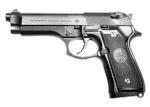
|
₳700 | Template:Country data tir Lhaeraidd |
9mm WACO | 
| |
| L2004 | 
|
₳800 | Template:Country data tir Lhaeraidd (Naval Issue) | 9mm WACO | 
| |
| Rifles | ||||||
| R1984 | File:Accuracy International AW.png | ₳2500 | Template:Country data tir Lhaeraidd | 7.62mm WACO | 
| |
| R1995 | 
|
₳4500 | Template:Country data tir Lhaeraidd | 12.7mm WACO | 
| |
| R2004 | 
|
₳5000 | Template:Country data tir Lhaeraidd | 12.7mm WACO | 
| |
| R1992 | 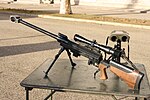
|
₳9500 | Template:Country data tir Lhaeraidd | 12.7mm WACO | 
| |
| AG1958 | 
|
₳2500 | Template:Country data tir Lhaeraidd (Naval Issue) |
7.62mm WACO | 
| |
| AG2005 | 
|
₳3000 | Template:Country data tir Lhaeraidd | 5.56mm WACO | 
| |
| SMGs | ||||||
| PL1963 | ₳1200 | Template:Country data tir Lhaeraidd | 9mm WACO | 
| ||
| Machine Guns | ||||||
| GP1960 | 
|
₳3500 | Template:Country data tir Lhaeraidd |
5.56mm WACO | 
| |
| GP1957 | File:M60GPMG.jpeg | ₳6000 | Template:Country data tir Lhaeraidd |
7.62mm WACO | 
| |
| Vehicle | Image | Cost | In use by | Details | Manufacturer | |
|---|---|---|---|---|---|---|
| Armoured Fighting Vehicles | ||||||
| SSV Mk2 | 
|
Classified | Template:Country data tir Lhaeraidd | Steadily being phased into regular use so as to replace the ageing CVR (T). | ||
| MF AFV1 | 
|
Classified | Template:Country data tir Lhaeraidd | The Army maintains just over a thousand of these vehicles while the National Guard and Reserves maintain a combined three hundred. Most were upgraded in 2010 with new turret and armour configurations. | ||
| G AFV2 | 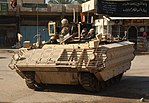
|
Classified | Template:Country data tir Lhaeraidd | Despite efforts to upgrade this line of vehicles Army funding for the project was withdrawn and the vehicles are now being replaced, principally with the Grendel SSV Mk2. | ||
| Infantry mobility Vehicles | ||||||
| MF IMV2 | 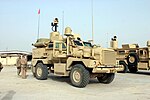
|
Classified | Template:Country data tir Lhaeraidd | Approximately one and a half thousand of these vehicles are maintained throughout the armed forces with many variants in use including 4x4 and 6x6 models. Funding for continuing development of the design has been secured. | ||
| MF AWV1 | 
|
Classified | Template:Country data tir Lhaeraidd | As part of a continuing program of equipment assessment and development the Cynol is being retained for improvements in design. | ||
| MF LIV2 | 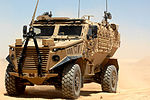
|
Classified | Template:Country data tir Lhaeraidd | Brought in to replace the obsolete MG LIV1. | ||
| Main Battle Tanks | ||||||
| G MBT 1 | 
|
Classified | Template:Country data tir Lhaeraidd | The MBT of the Lhaeraidh Army, which currently owns and maintains approximately 500 of the newer A5 model. | ||
| Artillery | ||||||
| G MRS1 | 
|
Classified | Template:Country data tir Lhaeraidd | Used in significant number with 112 active units and a further 30 in storage. | ||
| D ASP3 | 
|
Classified | Template:Country data tir Lhaeraidd | The largest piece of field artillery used by the R-FA. This self-propelled howitzer forms the bulk of the R-FA's regular artillery force. | 
| |
| Aircraft | ||||||
| G GAH6 | 
|
Classified | Template:Country data tir Lhaeraidd | The primary heavy attack and emergency transport helicopter of the R-A. | ||
| G VUH10 | 
|
Classified | Template:Country data tir Lhaeraidd | The primary transport, support, and utility helicopter of the R-A. | ||
| HA MRA5 | 
|
Classified | Template:Country data tir Lhaeraidd | The primary multi-role jet used by the R-A. | 
| |
